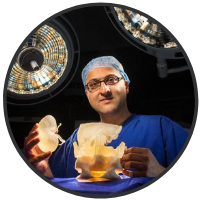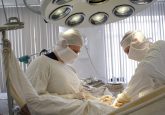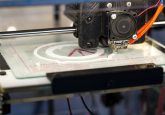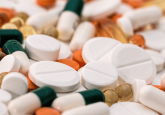3D printing for complex pediatric transplantation


In this interview, Pankaj Chandak (Guy’s, St Thomas’ and Great Ormond Street Hospitals and King’s College London, UK) describes how he uses 3D printing for complex pediatric transplant procedures and what to look forward to at 3DMedLIVE 2019: 3D printing in surgery.
Biography

Pankaj Chandak is a Specialist Registrar in Transplant Surgery at Guy’s, St Thomas’ and Great Ormond Street Hospitals (London, UK) and a Research Fellow, at King’s College London (UK). His interests include complex pediatric transplantation and applications of machine organ perfusion technology and innovation. Pankaj is using a novel bypass machine (ex vivo normothermic perfusion) to pump human kidneys from deceased donors to determine ways to protect the organ, prior to transplantation, with therapeutic agents that bind to the kidney to prevent organ rejection and help regeneration. This research may help to overcome immunological barriers. Furthermore, Pankaj’s multidisciplinary work has led to integration of 3D printing into complex pediatric transplantation, to aid the planning of challenging kidney transplants in children. The original 3D models used in the planning of a transplant of this kind using this technology have been accepted by the Science Museum in London (UK) for permanent exhibition for their new Medical Galleries 2019.
Pankaj has received several prestigious awards including The Royal Society of Medicine Norman Tanner Medal, The Cutler’s Clark Medal and The Royal College of Surgeons of England Joseph Lister Prize and Medal. In addition, he delivered The British Science Association Charles Darwin Award Lecture at the British Science Festival in 2017 is also recipient of the Royal College of Surgeons Arnott Lecture and Medal, delivered at the British Transplantation Society 2016. Pankaj has been invited speaker to The Royal Society, The Royal Institution, The Academy of Medical Sciences, The Women’s Institute, Parliament and Human Tissue Authority amongst others. He is recipient of The International Pediatric Transplant Young Scholar Award 2017.
Public engagement activities include appearances for film and radio including the on the BBC and BBC World Service. He has undertaken school science activities and has also set up the first Children’s Transplant Choir called ‘Harmonies of Hope‘ funded by BBC Children in Need. Pankaj was also medical advisor for the Netflix series, The Crown and along with his team, has appeared in Episode 1, playing the surgeons operating on the King George VI — a first for television where real surgeons act in film. He has been elected a Fellow of the Royal Asiatic Society (FRAS) and a Fellow of the Linnean Society (FLS).
>> Find out more about 3DMedLIVE
Register as a member of 3DMedNet for exclusive 3DMedLIVE updates
How do you utilize 3D printing technologies for complex pediatric transplantation?
The two challenges in complex pediatric transplantation are size discrepancy between the adult donor organ and the smaller child into whom the organ is going into and the possibility of anatomical abnormalities within the child, making the implantation procedure challenging.
Using preoperative 3D printing of patient specific models enables the transplant surgical team to plan, rehearse and discuss the best approach in trying to implant an adult sized donor kidney (from mum or dad) into a small child recipient (<20kg) who may also have complex vascular abnormalities. After reviewing conventional imaging such as CT and MR, these children are, at times, deemed challenging to transplant due to presence of significant abnormalities in their blood vessels or anatomy and they are explored surgically to establish feasibility prior to the donor surgery commencing. 3D printing offers a novel, cutting edge, improved, hands-on modality of determining feasibility in these challenging cases essentially helping to reduce uncertain operative feasibility. It is useful for consenting patients as the models are anatomically patient specific and children receiving the kidney feel more involved in their care having seen the model of ‘Mum or Dad’s kidney going into their abdomen’. This is important to maintain compliance of immunosuppressive medication in the long term amongst children.
>> Find out more about Pankaj’s earlier work in this full interview from October 2016
Without giving too much away, what do you hope are the key points for the audience to take away from your talk at 3DMedLIVE 2019: 3D printing in surgery?
- The importance of a multidisciplinary approach to complex cases;
- At times you may have to use unconventional surgical approaches;
- Try and utilize and integrate all forms of preoperative imaging modalities to give optimum planning strategies.
What are you most looking forward to at 3DMedLIVE 2019? What are your highlights from the programme?
All of it!
Why do you think events like 3DMedLIVE are important in progressing the field?
They highlight the interdisciplinary collaborative efforts from science and clinical departments for the benefit of patient care. It is important to learn how we can help our patients using the science from different disciplines all with a common aim of helping those in need.
You may also be interested in this video series from Pankaj at the Science Museum (London, UK):
- Exploring the history of innovation in surgery
- 3D printing and the history of surgery: engaging the public with surgical innovation (part 1)
- 3D printing and surgery in society: engaging the public with surgical innovation (part 2)
FAQ: from the Editor
How is 3D printing being used in pediatric medicine?
Advances in 3D printing have been life changing for children and in the field of pediatric medicine, especially in the adaptation of surgical tools, preoperative rehearsal of complex surgeries (as described in this interview), personalized treatments and custom-designed prostheses to suit growing bodies.
Earlier this year, 3DMedNet interviewed experts using 3D printing technologies to create customized solutions for complex challenges within pediatric medicine. Find out more with our 3D in focus: applications in pediatrics feature.

How has 3D printing been used in transplant surgeries?
3D printing solutions for transplant procedures have made the news for a variety of cases including tissues of various densities, including:
- Complex kidney transplant made possible by 3D printing
- Patient receives 3D-printed vertebrae transplant in India first
- Pioneering middle ear transplant surgery uses 3D-printed bones
It is also worth mentioning, however, that bioprinting and regenerative medicine research could be paving the way towards the implantation of laboratory grown and 3D-printed tissues, or even the xenotransplantation of viable human tissues from animals.
The opinions expressed in this feature are those of the interviewee and do not necessarily reflect the views of 3DMedNet or Future Science Group.





